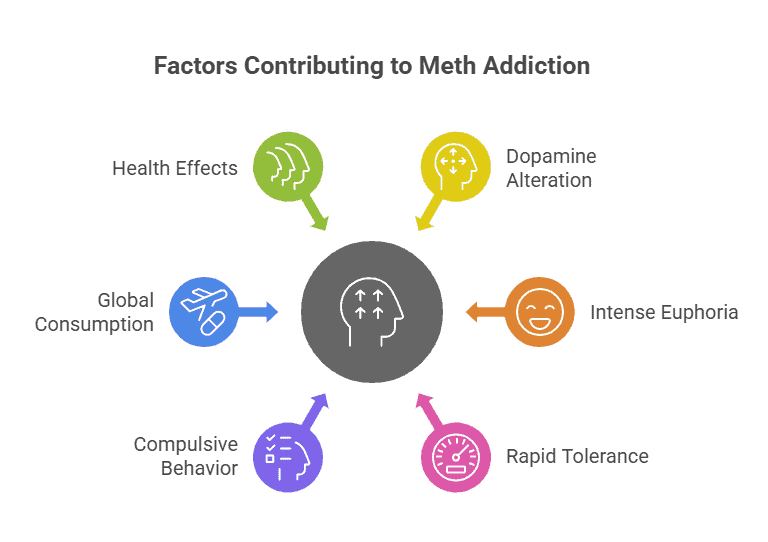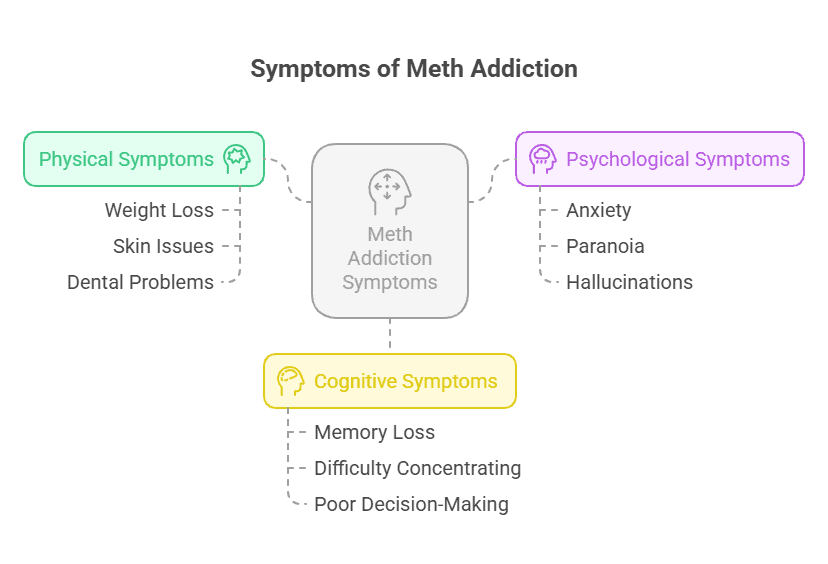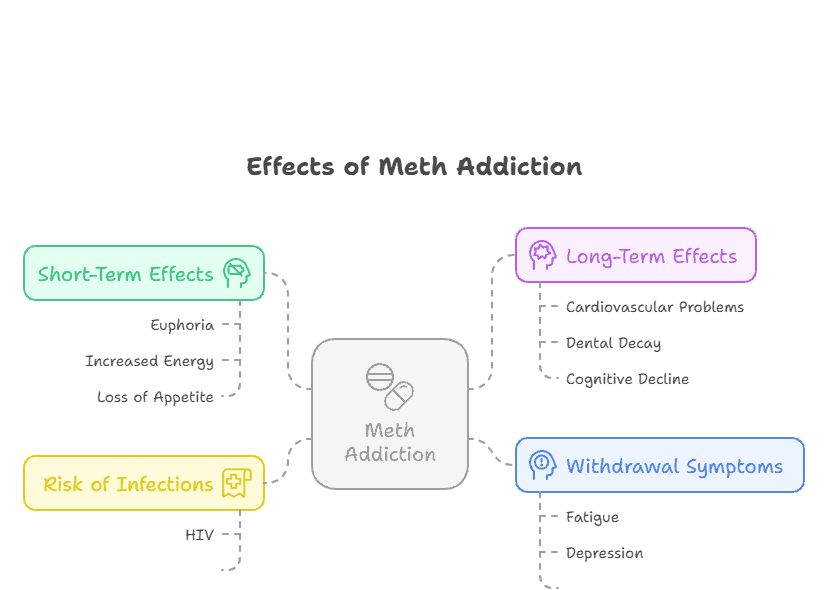Meth addiction is a growing public health concern that impacts individuals, families, and communities worldwide. Methamphetamine, more colloquially known as crystal meth (ice/yaba), is a powerful stimulant that brings about severe physical, psychological, and cognitive problems when misused.
The National Survey on Extent and Pattern of Substance Use in India (2019) reported that about 1.08% of the population (over 11 million people) had used amphetamines, including methamphetamine, in their lifetime. Among these, a significant number of users are young, with around 400,000 users in the 10-17 age group.
The causes of meth addiction stem from genetic predispositions, environmental influences, mental health issues, or peer pressure.
Common symptoms of meth addiction string from extreme weight loss and skin sores to paranoia, hallucinations, and memory loss.
The effects of meth addiction are devastating, as individuals experience bursts of energy, euphoria, reduced appetite, cardiovascular problems, severe dental decay (“meth mouth”), cognitive decline, and even permanent brain damage.
Withdrawal from meth is equally challenging, marked by fatigue, depression, mood swings, and intense drug cravings, which makes relapse common.
Fortunately, meth addiction is treatable through de-addiction programs like detox, behavioural therapies, and inpatient or outpatient treatment approaches.

What Is Meth Addiction?
Meth addiction is a chronic condition in which an individual develops a compulsive need to use methamphetamine. This highly addictive stimulant alters the brain’s dopamine system and disrupts normal decision-making, impulse control, and reward processing.
Common street names for meth include crystal, ice, crank, speed, and glass. Because meth produces intense and long-lasting euphoria, dependence develops quickly, after just a few uses, making it one of the most addictive substances.
What Is Meth?
Meth, or methamphetamine, is a potent stimulant drug that directly impacts the central nervous system by raising levels of dopamine in the brain, which heightens pleasure, alertness, and energy. People struggling with meth use experience symptoms such as intense cravings, rapid tolerance, and compulsive drug-seeking behaviour, which highlight its addictive nature.
Methamphetamine is the most widely consumed synthetic stimulant worldwide, with global seizures reaching 325 tons in 2019, over 70% of all amphetamines seized, primarily in China, Mexico, Myanmar, Thailand, and the United States, according to according to the UNODC World Drug Report 2021 and 2025, European Monitoring Centre for Drugs and Drug Addiction (EMCDDA)
The drug is routinely found as a white crystalline powder or as crystal meth, a glass-like substance that is smoked, snorted, injected, or swallowed.
Meth was originally developed in the early 20th century for medical use in conditions like ADHD and obesity, but its high potential for misuse and addiction has limited its medical applications.
Prolonged meth use builds up rapid tolerance, dependence, and devastating effects on physical and mental health, including cardiovascular strain, severe dental problems (“meth mouth”), and long-term cognitive decline. These dangers make meth a major focus of de-addiction programs and behavioural health interventions across India and worldwide.
How Is Meth Used?
Meth is used through smoking, snorting, injecting, and oral ingestion. Smoking meth in crystalline form is one of the most common methods, producing almost immediate effects as the drug rapidly enters the bloodstream through the lungs.
Snorting meth provides a slower onset but longer-lasting effects, while injecting delivers the most intense and dangerous “rush.” Oral ingestion, though less common, involves swallowing pills or powder and results in delayed but sustained effects. Each method of use carries major risks, with injection posing additional dangers such as infections and transmission of blood-borne diseases.
What Are the Causes of Meth Addiction?
The causes of meth addiction are genetic predisposition, environmental influences, trauma, peer pressure, co-occurring disorders, and social stressors. Meth addiction develops due to a combination of biological vulnerabilities and external circumstances.
Common causes of meth addiction are given below:
- Genetic Factors: Family history of addiction accelerates susceptibility by altering how the brain responds to meth.
- Environmental Factors: Growing up in environments with drug availability or a lack of parental supervision raises the risk.
- Co-Occurring Disorders: Individuals with depression, ADHD, or anxiety misuse meth to self-medicate.
- Peer Pressure: Social circles that normalise drug use strongly influence first-time experimentation.
- Trauma: Childhood abuse or unresolved trauma breeds substance use as a coping mechanism.
What Are the Symptoms of Meth Addiction?
The symptoms of meth addiction are physical changes, psychological disturbances, and cognitive impairments. Physically, users experience rapid weight loss and skin issues; psychologically, paranoia and anxiety are common; and cognitively, meth impairs memory and learning.
The symptoms of meth addiction include:
- Weight loss and malnutrition
- Anxiety and mood swings
- Paranoia and hallucinations
- Insomnia and restlessness
- Memory loss and difficulty concentrating
Physical Symptoms of Meth Addiction
The physical symptoms of meth addiction are given below:
- Substantial weight loss and muscle wasting
- Severe dental problems (“meth mouth”)
- Skin sores and frequent infections
- Dilated pupils and rapid eye movement
- Hyperactivity and uncontrollable physical movements
Psychological Symptoms of Meth Addiction
The psychological symptoms of meth addiction consist of:
- Severe anxiety and panic attacks
- Depression and suicidal thoughts
- Hallucinations (visual and auditory)
- Paranoia and irrational fears
- Insomnia and chronic restlessness

Cognitive Symptoms of Meth Addiction
The cognitive symptoms of meth addiction are as follows:
- Short-term memory loss
- Difficulty with verbal learning
- Slower reaction times
- Poor decision-making abilities
- Impaired attention and focus
What Are the Effects of Meth Addiction?
The common effects of meth addiction are short-term euphoria, heightened energy, increased wakefulness, as well as long-term cardiovascular damage, dental decay, and cognitive decline. In the short term, meth enhances mood and confidence, but over time, its neurotoxic effects solidify irreversible harm to both physical health and brain function.
Short-Term Effects of Meth Addiction
The short-term effects of meth addiction are spotlighted below:
- Intense euphoria and elevated mood
- Nascent wakefulness and energy
- Augmented confidence and talkativeness
- Loss of appetite
- Rapid heart rate and increased body temperature

Long-Term Effects Of Meth Addiction
The long-term effects of meth addiction are listed below:
- Cardiovascular problems such as hypertension and arrhythmias
- Severe dental decay (“meth mouth”)
- Cognitive decline and memory problems
- Elevated risk of stroke and brain damage
- Persistent mood disorders like depression and paranoia
How Does Meth Addiction Increase The Risk Of HIV And Hepatitis?
Meth addiction increases the risk of HIV and hepatitis primarily through sharing contaminated injection equipment and engaging in high-risk sexual behaviour. Injecting meth exposes users to blood-borne viruses, while the drug’s stimulating effects decrease inhibitions, leading to multiple partners and unsafe sexual practices, compounding the spread of infections.
What Are the Withdrawal Symptoms of Meth Addiction?
The common withdrawal symptoms of meth addiction are fatigue, depression, intense cravings, irritability, mood swings, muscle aches, and headaches. Withdrawal occurs because the brain becomes dependent on meth to regulate dopamine levels. Symptoms last from several days to weeks, depending on the severity of addiction.
Common withdrawal symptoms of meth addiction are indicated below:
- Anxiety and panic
- Intense cravings for meth
- Irritability and anger
- Severe fatigue and sleep problems
- Muscle aches and headaches
- Depression and suicidal thoughts
- Mood swings and restlessness
- Amplified appetite
How Long Does Meth Stay In Your System?
Meth stays in the body for 1 to 4 days, though traces are identified for up to 90 days, provisional on the drug testing method. Common detection techniques are urine, blood, saliva, and hair tests, each with its detection window. The accuracy and duration of these tests are influenced by dosage, frequency of use, metabolic rate, and individual body composition. The detection windows for meth using various methods are noted below:
- Blood: up to 1-3 daysd
- Urine: 3-7 days
- Saliva: 1-4 days
- Hair: up to 90 days or longer
What Is the Treatment for Meth Addiction?
The common treatment for meth addiction is detoxification, medications, inpatient treatment, outpatient treatment, and behavioural therapies. Each treatment addresses the physical and psychological aspects of addiction.
The treatment for meth addiction is given below:
- Detoxification: Medical supervision manages withdrawal safely.
- Medications: Though no FDA-approved medications exist specifically for meth, some antidepressants and anti-anxiety drugs are used to ease symptoms.
- Inpatient Treatment: 24/7 supervised care in rehab centres with structured therapies.
- Outpatient Treatment: Flexible programs allowing patients to live at home while attending regular therapy.
- Behavioural Therapies: Evidence-based methods like Cognitive Behavioural Therapy (CBT) and Contingency Management (CM) to curtail relapse and alter destructive thought patterns.
How to Prevent Relapse After Meth Addiction Treatment?
To prevent relapse after meth addiction treatment, individuals must focus on identifying triggers, building a healthy support network, and committing to ongoing therapy and counselling. Recognising high-risk situations and learning effective coping strategies helps prevent vulnerability to cravings.
Establishing reassuring connections with family, peers, or recovery groups provides accountability and encouragement. Continued therapy, such as Cognitive Behavioural Therapy (CBT), reinforces positive behaviours and emotional stability. Additionally, maintaining a structured routine, prioritising physical health through exercise and sleep, and avoiding environments linked to past drug use are foundational strategies to pivot long-term recovery.





